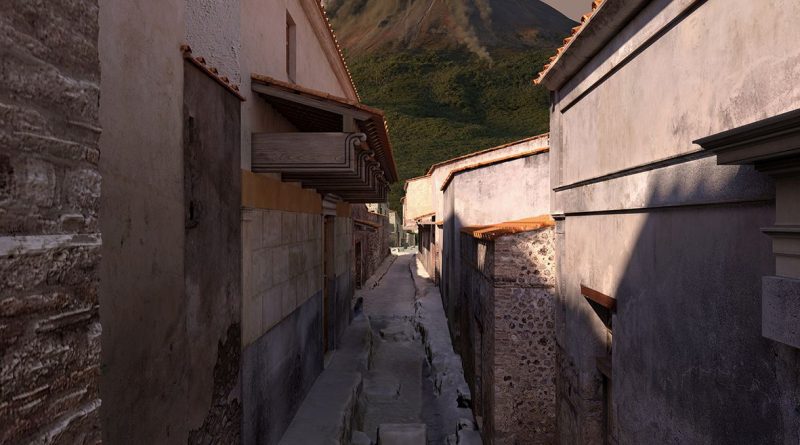Paris Exhibition Recreates Pompeii’s Final Hours | Smart News
[ad_1]
When Mount Vesuvius erupted in 79 A.D, its lava and ash preserved Pompeii’s last moments in stunning detail. From public buildings and private homes adorned with elaborate mosaics and frescoes to carbonized food and the remains of people entombed where they fell, excavations in the hundreds of years since Pompeii’s 16th-century rediscovery have yielded an array of insights on the doomed Roman city.
Now, a new exhibition at the Grand Palais in Paris places visitors in Pompeii just hours before Vesuvius’ eruption. Fittingly titled “Pompeii,” the show—created in collaboration with the Pompeii Archaeological Park—uses immersive 3-D imagery to present recreations of both the ancient city and the modern archaeological site. Researchers drew on a combination of drone footage, laser cartography, infrared imagery and photogrammetry to bring Pompeii back to life, reports Agence France-Presse (AFP).
Originally slated to open in March, “Pompeii” was one of many exhibitions delayed by the COVID-19 pandemic. Would-be visitors received a digital preview of the show in April, when the Grand Palais released a trove of related resources, including virtual and augmented reality experiences, an audio guide, and video tours. The online portal’s in-person counterpart opened July 1 and is scheduled to run through September 27.
“[T]his show is not about the technology but about the place,” Roei Amit, head of the Paris cultural institution’s digital department, tells the Financial Times’ Edwin Heathcote. “We have virtual reality and augmented reality of course but they are not central to the exhibition. Instead we are making a hybrid experience, about how we can tell the story in the best way.”
Speaking with AFP, organizers describe the exhibition as a veritable “time machine.” Visitors walk through a 200-foot-long alleyway surrounded by lifelike recreations of Pompeiian houses, fountains and passersby; “[l]ayers of present and past are overlaid as ruins return to pristine dwellings inhabited by slightly cheesy-looking, toga-wearing inhabitants while fountains trickle in courtyards,” according to the Times.
/https://public-media.si-cdn.com/filer/06/2b/062bc36d-e460-4796-9b69-e3fc0dd2feea/reconstitution_rue_pompeienne.jpg)
(© GEDEON Programmes)
“Pompeii” is divided into four domus—the Latin word for home. Per an exhibition map, the first centers on Pompeii as a Roman city, while the other three explore early and recent excavations, specific discoveries, and frescoes, respectively.
Items on view include a statue of Livia, wife of Emperor Augustus; a marble rabbit; a witch’s chest filled with amulets made of glass, ivory and amethyst; gold jewelry shaped like snakes; and plaster casts of people who died under Vesuvius’ ash. The casts are flanked by frescoes depicting such scenes as the goddess Venus riding in an elephant-drawn chariot.
Above the makeshift city, Mount Vesuvius—as seen on a looming video loop—rumbles ominously. Every 30 minutes, the volcano erupts, reminding visitors of Pompeii’s inevitable end.
At the time of the eruption, between 15,000 and 20,000 people lived in Pompeii and nearby Herculaneum. The majority of these individuals managed to escape Vesuvius’ wrath, but around 2,000 fell victim to the volcano’s molten rock, flaming debris and poisonous gases, reported Laura Geggel for Live Science in 2019.
The exhibition’s reconstruction of Pompeii is “not at all a Disneyland version,” Pompeii Archaeological Park director Massimo Osanna tells AFP. “What we have shown in 3-D corresponds exactly with our scientific research.”
“Pompeii” is on view at the Grand Palais in Paris through September 27, 2020. Some materials from the show are available to view online.
[ad_2]
Shared From Source link Arts
